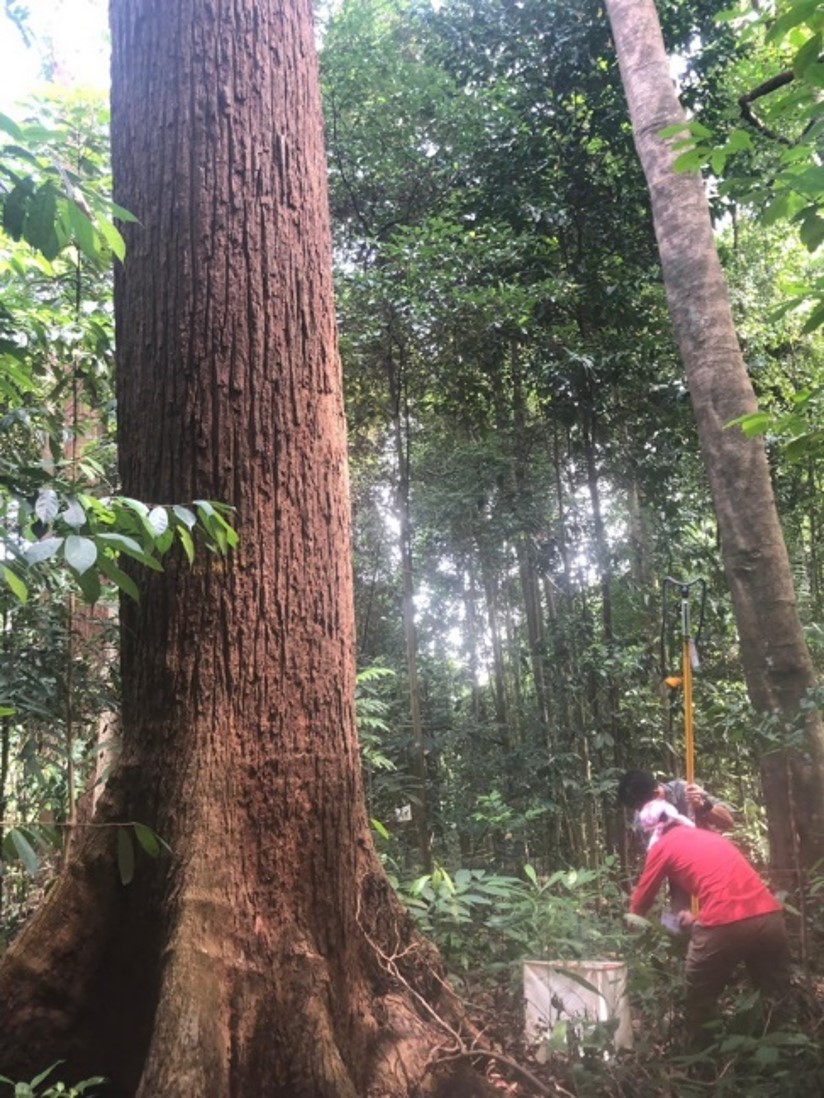Kang Min Ngo is the Research Coordinator at the Asian School of the Environment, Nanyang Technological University (NTU), host institution of the Bukit Timah, Singapore FDP and the ForestGEO Asia Program headquarters. In 2010 and 2013 she received support from ForestGEO’s Research Grants Program, and in 2019 she helped coordinate the logistics of the Annual ForestGEO Analytical Workshop in Singapore. Kang Min loves field work and, in her spare time, is currently overseeing a rewilding project.
When did you realize you wanted to be a scientist/work in forest ecology? How did you decide to go down this career path?
Although I was looking for ecology-related jobs, I did not actually set out wanting to study forest ecology after graduation. It was almost by accident that I joined the ForestGEO [then CTFS-AA] Singapore office at the National Institute of Education as a temporary staff member. I learned about this job from a mutual friend of Siew Chin Chua, and in that role, I helped Siew Chin with field work and seed sorting for her forest restoration project. From there I began to immerse myself in forest ecology and eventually became full-time staff.

What led you down the path to your current job? What has been your biggest challenge in getting to this point in your career?
Even though I got into forest ecology serendipitously, I have been doing research in the Bukit Timah ForestGEO plots since the 2008 census. At that time I was helping Nik Faizu bin Nik Hassan, who was leading the census. He is now working for the Pasoh project.
It was a steep learning curve at first, from learning how to identify the tree species, to learning how to perform the statistics, to using the R software for analyses. Through the years I have encountered numerous challenges, including: reviewer comments and rejections, dealing with the park managers and getting them to grant research permits to us, and obtaining funding for major census projects. I would not have gotten here if not for the help, guidance, and companionship of friends and colleagues who have walked this journey with me. Even now I am learning to overcome structural and institutional obstacles, and I am glad to have supportive mentors around me.
What is the most interesting or unique aspect of your site?
The Bukit Timah site is unique in its urban setting. There are very few biodiverse tropical primary forests in the world that are so urban at the same time; Bukit Timah is completely encircled by urban infrastructure like roads and houses. We have two 2-ha plots, one in primary forest, and one in secondary forest. You can hear the road traffic from the nearest expressway while standing in the secondary forest plot. It is also a quick drive to some of the most well-equipped labs in the world, making it very suitable for doing time-sensitive molecular and physiological work on plants and animals.

What questions are you currently addressing in your research/site?
Our research so far has centered on the effects of isolation and fragmentation on primary and secondary forests in our site. Despite two centuries of human disturbances, Bukit Timah still has considerable levels of biodiversity. There were predictions that Bukit Timah Forest would collapse and die out from the fragmentation effects, however, our long-term plot data has shown that the primary forest is surviving well, with most primary forest species still recruiting and growing. That said, the forest is changing with increasingly extreme weather variables.
I am currently preparing a manuscript that examines potential recovery rates of secondary forest at Bukit Timah. Two lead PIs of the Forest Ecology group at NTU, Kelly Andersen and Eleanor Slade, both have research projects and students actively working on soils, roots, and invertebrates at the site. We also work with colleagues at the National Parks Board, a government agency, to look at questions related to phylogenomics and plant systematics at Bukit Timah.
What kind of capacity building opportunities does your site provide for students, early-career researchers, and the local community?
We welcome students who are interested to work at our site to participate through internships, part-time jobs, or research projects. I regularly take undergraduates from NTU to measure dendrometers in the plots, and we involve many students during our census work, which happens every five years. Students who do projects with us have access to the existing Bukit Timah census data while they collect their own measurements from the field.

What is your favorite part about your work?
Field work! When I first started out, I spent most of my time working in the field. But these days I am stuck at the computer for meetings, writing, or other paperwork. So now I enjoy every opportunity I have in the field.

What do you like to do when you’re not studying forest dynamics?
I spend a lot of my free time volunteering for the Nature Society (Singapore) and the local grassroots community. Currently I am overseeing a rewilding project at a nature corridor in Singapore, which has given me the opportunity to work with multiple government agencies and stakeholders on the ground. This rewilding project not only serves the wildlife that use the nature corridor, but also the humans that trek on this 24km long historical trail that is also rich in biodiversity.
Web Presence: Twitter
Selected Publications
Lum, S., and K. M. Ngo. 2021. Lessons in ecology and conservation from a tropical forest fragment in Singapore. Biological Conservation 254:108847.
Ngo, K. M., S. Davies, N. F. N. Hassan, and S. Lum. 2017. Resilience of a forest fragment exposed to long-term isolation in Singapore. Plant Ecology & Diversity 9:1–11. https://doi.org/10.1080/17550874.2016.1262924
Chua, S. C., B. S. Ramage, K. M. Ngo, M. D. Potts, and S. K. Y. Lum. 2013. Slow recovery of a secondary tropical forest in Southeast Asia. Forest Ecology and Management 308:153–160. https://doi.org/10.1016/j.foreco.2013.07.053
